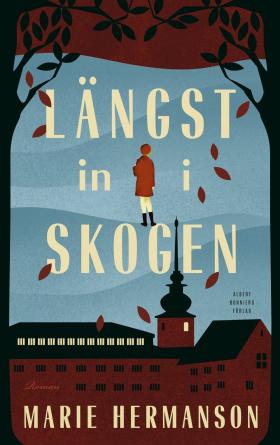
Längst in i skogen
(Deep in the Woods)
by Marie Hermanson
reviewed by Emma Olsson
A sign of a great detective novel? One where you sink into it and only realise later, perhaps a few chapters in, that the characters sound awfully familiar, perhaps a bit too familiar: have you met them before? But no, it’s just that they’re part of a series and you’ve happened to encounter them in the third book, in the midst of a story that’s been unraveling for some time. Only it doesn’t matter, because the book works as well as a standalone as part of a series, so you happily read on. As someone who only recently started dipping her toes in the detective genre, I’ve had this experience with the novels of Raymond Chandler and Georges Simenon. Now I’m experiencing it with Marie Hermanson.
A journalist, Ellen is the ‘New Woman’, a woman fit for the twentieth century who works (she’s a journalist – or at least was, but more on that later), drinks, and attends informal balls in the evening where she dances the night away with the daring ‘New Man’. Nils is a young detective on the rise, representing the new generation of man collaborating and sometimes clashing with the old, living alone in a deprived neighbourhood and harbouring a lingering love for Ellen, whom we learn he was once seriously involved with, but who has since gotten married to a successful young businessman and taken on a new role as ‘Wife’. At the start of the novel, Ellen and Nils’s relationship is fraught. Their union had been both romantic and professional, with Nils calling on Ellen for her insights on his cases. But now, what does he want from her when he dials her number? To come over and mind some children.
Alice, the eldest of the five Guldin children, has disappeared after running away from her nanny, an overworked and underpaid teenager named Maj, inside Gothenburg’s Natural History Museum. Nils is on the case, but he needs someone to look after the four remaining kids while he interrogates Maj. There are no women at the police station, so he phones Ellen.
Nils’s and Ellen’s stories barely touch, and when they do, it’s in brief, cursory encounters: exchanging pleasantries outside the courthouse, spotting one another from across the street and only managing a small wave. Ellen can’t help but feel slighted by Nils, hurt that he no longer seeks her insights to solve a crime. Restless and discouraged in her new role as housewife, she starts her own investigation into Alice’s disappearance. What unravels is two parallel inquiries - Ellen’s and Nils’s – for the reader to anxiously devour.
Meanwhile, the case is fascinating and piques interest. How does a nine-year-old child disappear from a museum? Through Nils and Ellen, we are introduced to the confounding Guldin family, with an alcoholic father drowning in debts and a sickly, bedridden mother. It’s no wonder sixteen-year-old Maj carries a heavy burden looking after the kids. Her role could be viewed as a foil to Ellen: the working class, child-rearing teen versus the wealthy, educated ‘New Woman’ who fears having children of her own. Yet Maj is also a reminder to Ellen and to the reader. She demonstrates the limits of social progress, something as relevant today as it was in 1920s Sweden.
Now back to the mystery. The story of how Alice disappeared from a quiet museum is a long-winded one. If you’re looking for brisk pacing and shocking twists, this is perhaps not the novel for you. Hermanson takes her time unraveling this mystery, making it all the more satisfying when things fall into place, though the novel resonates with a deep sadness that’s hard to separate from the thrill of a good whodunit.
My favourite part of the book? The dazzling sense of presence on each page. Historic Gothenburg is a breathing object, and Hermanson spares no detail in documenting its bars, its dance halls, its markets and its lunch spots. It’s clear she has spent a lot of time walking the streets of the city and researching its historic establishments. Beneath the mystery is another story, a slice-of-life novel about a certain city at a certain time and the people who live in it: the drunks, the cops, the writers, the maids. This quotidian adoration contributes to the novel’s languid quality. This is a book you want to read slowly on a Sunday morning.
Yet perhaps no place in Gothenburg was as frequented by Hermanson as the Natural History Museum, the novel’s centrepiece. She knows the museum inside and out, lovingly depicting its every room and crevice, from the world’s only mounted blue whale to the painstakingly painted nature dioramas. As the museum turns from a place of wonder to a crime scene, it’s impossible to look away.

Längst in i skogen
Albert Bonniers Förlag 2024, 362 pages
Foreign rights: Nordin Agency
Nominated for Svenska Deckarakademins (The Swedish Crime Writers' Academy) Best Crime Novel of 2024 and for the Årets Bok award, chosen by public vote.
Former journalist Marie Hermanson made her literary debut in 1986 with the story collection Det finns ett hål i verkligheten (There Is A Hole In Reality). In 1995 she was nominerad for the August Prize with the novel Värddjuret (The Host).
